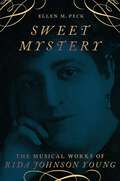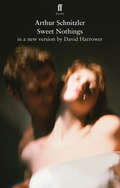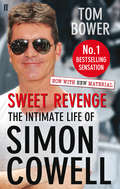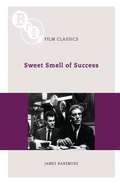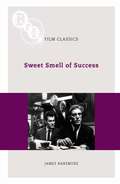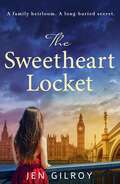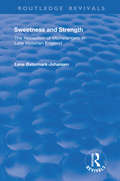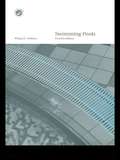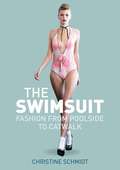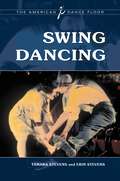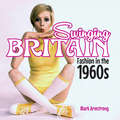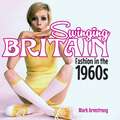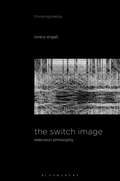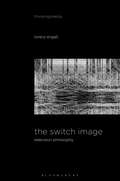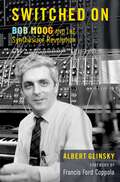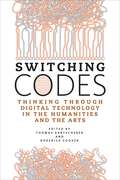- Table View
- List View
Sweet Mystery: The Musical Works of Rida Johnson Young (Broadway Legacies)
by Ellen M. PeckRida Johnson Young (ca. 1869-1926) was one of the most prolific female playwrights of her time, as well as a lyricist and librettist in the musical theater. She wrote more than thirty full-length plays, operettas, and musical comedies, 500 songs, and four novels, including Naughty Marietta, Lady Luxury, The Red Petticoat, and When Love is Young . Despite her extensive output, no significant study of her work has been produced. This book looks at her musical theater works with in-depth analyses of her librettos and lyrics, as well as her working relationships with other writers, performers, and producers, particularly Lee and J. J. Shubert. Using archival materials such as original typescripts, correspondence, and reviews, the book contextualizes her work in the early twentieth century professional theater and provides a window into the standard practices of writing and production of the era.
Sweet Mystery: The Musical Works of Rida Johnson Young (Broadway Legacies)
by Ellen M. PeckRida Johnson Young (ca. 1869-1926) was one of the most prolific female playwrights of her time, as well as a lyricist and librettist in the musical theater. She wrote more than thirty full-length plays, operettas, and musical comedies, 500 songs, and four novels, including Naughty Marietta, Lady Luxury, The Red Petticoat, and When Love is Young . Despite her extensive output, no significant study of her work has been produced. This book looks at her musical theater works with in-depth analyses of her librettos and lyrics, as well as her working relationships with other writers, performers, and producers, particularly Lee and J. J. Shubert. Using archival materials such as original typescripts, correspondence, and reviews, the book contextualizes her work in the early twentieth century professional theater and provides a window into the standard practices of writing and production of the era.
Sweet Nothings
by David HarrowerA young man has an affair with a married woman. He is terrified her husband will challenge him to a duel and kill him. Meanwhile he toys with the affections of another and, for a moment, life seems full of joy. The doorbell rings. The husband enters the room. Based on Schnitzler's play Liebelei, David Harrower's Sweet Nothings captures the power of sexual longing, the cruelty of tradition and the vulnerability of those in love. The play premieres at the Young Vic, London, in March 2010.'I write of love and death. What other subjects are there?'Arthur Schnitzler.
Sweet Revenge: Updated Edition
by Tom BowerIlluminating the life of Simon Cowell and delving into backstage scandal, tabloid rumour and the cut-throat worlds of music and television, Tom Bower leaves no stone unturned in this must-read biography. This is a detailed insider's account of entertainment mogul Simon Cowell's rise to meteoric fame and all of the controversial highs and lows along the way. Packed with juicy details, exclusive interviews and sensational revelations, Sweet Revenge is an incredible portrait of Simon Cowell which also uncovers the real stories behind The X Factor, Britain's Got Talent and American Idol. Tom Bower is the author of nineteen books, including biographies of Robert Maxwell, Mohamed Fayed, Gordon Brown, Richard Branson, Conrad Black and, more recently, Bernie Ecclestone.
Sweet Smell of Success (BFI Film Classics)
by James NaremoreThe highest artistic achievement of Hecht-Hill-Lancaster, an innovative production company that emerged in Hollywood at the end of the classic studio system, Sweet Smell of Success (1957) portended the collapse of Breen-Office censorship and was the first US entertainment film to depict McCarthy-style exploitation of the press. It also presented an unusually dark view of the culture of celebrity, presaging developments of an even darker kind in our own day. Sweet Smell's frightening portrayal of a newspaperman loosely based on Walter Winchell and its unstinting depiction of corruption and sleaze in the world of Broadway theatres and nightclubs have given it a legendary reputation; critics and film-makers continue to praise the whiplash dialogue of Clifford Odets and Ernest Lehman, the seductive location photography of James Wong Howe, the stylish direction of Alexander Mackendrick and the disturbing performances of Burt Lancaster and Tony Curtis as ruthless gossip columnist J. J. Hunsecker and his ambitious but doomed acolyte, Sidney Falco.James Naremore's masterly study of Sweet Smell of Success offers new information about the many revisions of the screenplay, the production company's negotiations with censors and the tense circumstances under which the film was shot and received by the public. Naremore places the film in its historical context, arguing that it functioned as the revenge of the Hollywood left against a repressive political and media environment that was beginning to change and momentarily lose its power. He also provides a detailed commentary on the finished product, analysing the important contributions of its several talented creators.
Sweet Smell of Success (BFI Film Classics)
by James NaremoreThe highest artistic achievement of Hecht-Hill-Lancaster, an innovative production company that emerged in Hollywood at the end of the classic studio system, Sweet Smell of Success (1957) portended the collapse of Breen-Office censorship and was the first US entertainment film to depict McCarthy-style exploitation of the press. It also presented an unusually dark view of the culture of celebrity, presaging developments of an even darker kind in our own day. Sweet Smell's frightening portrayal of a newspaperman loosely based on Walter Winchell and its unstinting depiction of corruption and sleaze in the world of Broadway theatres and nightclubs have given it a legendary reputation; critics and film-makers continue to praise the whiplash dialogue of Clifford Odets and Ernest Lehman, the seductive location photography of James Wong Howe, the stylish direction of Alexander Mackendrick and the disturbing performances of Burt Lancaster and Tony Curtis as ruthless gossip columnist J. J. Hunsecker and his ambitious but doomed acolyte, Sidney Falco.James Naremore's masterly study of Sweet Smell of Success offers new information about the many revisions of the screenplay, the production company's negotiations with censors and the tense circumstances under which the film was shot and received by the public. Naremore places the film in its historical context, arguing that it functioned as the revenge of the Hollywood left against a repressive political and media environment that was beginning to change and momentarily lose its power. He also provides a detailed commentary on the finished product, analysing the important contributions of its several talented creators.
The Sweetheart Locket: A gripping and emotional WW2 page turner
by Jen Gilroy'A story that will linger in your heart long after you finish it' Maisie ThomasWhat if the key to your present lies in the past?London, 1939On the eve of the Second World War, Canadian Maggie Wyndham defies her family and stays in England to do her bit for the war effort. Torn between two countries, two men and living a life of lies working for the Special Operations Executive (SOE), Maggie's RAF sweetheart locket is part of who she is...and who she isn't.San Francisco, 2019Over twenty years after Maggie's death, her daughter Millie and granddaughter Willow take a DNA test that's supposed to be a bit of fun but instead yields unexpected results. Willow has always treasured her grandmother's sweetheart locket, both family heirloom and a symbol of her grandparents' love story. But now she doesn't know what to believe. She embarks on a search for the truth, one she doesn't know will reveal far more about herself...A gripping and heart-breaking dual timeline novel about love, loss and buried secrets, The Sweetheart Locket is perfect for fans of Lorna Cook, Rachel Hore and Suzanne Kelman.
Sweetness and Strength: The Reception of Michelangelo in Late Victorian England (Routledge Revivals)
by Lene Østermark-JohansenFirst published in 1998, this volume explores the reinvention of Michelangelo in the Victorian era. At the opening of the nineteenth century, Michelangelo’s reputation rested on the evidence of contemporary adulation recorded by Vasari and Condivi. Travel, photography, the shift of his drawings into public collections, and, in particular, the publication of his poems in their original form, transformed this situation. The complexity of his work commanded new attention and several biographies were published. As public curiosity and knowledge of the artist increased, so various groups began to ally themselves to aspects of Michelangelo’s persona. His Renaissance reputation as a towering genius, a man of great spiritual courage, who had journeyed through and for his art to the depths of despair, was important to the Pre-Raphaelites and other artists. His love for his own ‘Dark Lady’, Vittoria Colonna, aroused excited speculation among High Church advocates, who celebrated his friendship with the deeply religious woman-poet; and the emerging awareness that some half of his love poetry was dedicated to a younger man, Tommaso de’ Cavalieri, was of intense interest to the aestheticists, among them Oscar Wilde, Walter Pater and J.A. Symonds, who sought heroic figures from societies where masculinity was less rigorously defined. In this original and beautifully illustrated study, Lene Østermark-Johansen shows how the critical discussion of the artist’s genius and work became irretrievably bound up in contemporary debates about art, religion and gender and how the Romantic view of art and criticism as self-expression turned the focus from the work of art to the artist himself such that the two could never again be viewed in isolation.
Sweetness and Strength: The Reception of Michelangelo in Late Victorian England (Routledge Revivals)
by Lene Østermark-JohansenFirst published in 1998, this volume explores the reinvention of Michelangelo in the Victorian era. At the opening of the nineteenth century, Michelangelo’s reputation rested on the evidence of contemporary adulation recorded by Vasari and Condivi. Travel, photography, the shift of his drawings into public collections, and, in particular, the publication of his poems in their original form, transformed this situation. The complexity of his work commanded new attention and several biographies were published. As public curiosity and knowledge of the artist increased, so various groups began to ally themselves to aspects of Michelangelo’s persona. His Renaissance reputation as a towering genius, a man of great spiritual courage, who had journeyed through and for his art to the depths of despair, was important to the Pre-Raphaelites and other artists. His love for his own ‘Dark Lady’, Vittoria Colonna, aroused excited speculation among High Church advocates, who celebrated his friendship with the deeply religious woman-poet; and the emerging awareness that some half of his love poetry was dedicated to a younger man, Tommaso de’ Cavalieri, was of intense interest to the aestheticists, among them Oscar Wilde, Walter Pater and J.A. Symonds, who sought heroic figures from societies where masculinity was less rigorously defined. In this original and beautifully illustrated study, Lene Østermark-Johansen shows how the critical discussion of the artist’s genius and work became irretrievably bound up in contemporary debates about art, religion and gender and how the Romantic view of art and criticism as self-expression turned the focus from the work of art to the artist himself such that the two could never again be viewed in isolation.
SWIM (Modern Plays)
by Liz RichardsonThe sensation of waterflowing around my bodyhappily floating down a river,watching the banks pass me by.I like to take the same journey as a riverit's the lack of control which feels so good,it's good to leave my life alone for a while.Liz grew up in the Lake District. She spent her childhood walking in the fells, playing in the lakes and in the river at the end of her garden. After time away living in the City, Liz returns to the hills and into a new village for a new chapter of her life. But when her new community is rocked by tragedy, Liz rediscovers outdoor swimming and how it can keep both her and her new friends afloat.Filled with humour and heart, live music and projection, Swim is a tender tale based on a true story.This edition was published to coincide with the run at Theatre by the Lake in Keswick, in March 2022.
SWIM (Modern Plays)
by Liz RichardsonThe sensation of waterflowing around my bodyhappily floating down a river,watching the banks pass me by.I like to take the same journey as a riverit's the lack of control which feels so good,it's good to leave my life alone for a while.Liz grew up in the Lake District. She spent her childhood walking in the fells, playing in the lakes and in the river at the end of her garden. After time away living in the City, Liz returns to the hills and into a new village for a new chapter of her life. But when her new community is rocked by tragedy, Liz rediscovers outdoor swimming and how it can keep both her and her new friends afloat.Filled with humour and heart, live music and projection, Swim is a tender tale based on a true story.This edition was published to coincide with the run at Theatre by the Lake in Keswick, in March 2022.
Swimming Pools: Design and Construction, Fourth Edition
by Philip H. PerkinsThe fourth edition of this classic book provides a comprehensive treatise on the design and construction of swimming pools, both public and private. Significantly revised, it covers planning, materials, design, construction and finishing, water circulation and treatment, energy conservation, maintenance and repairs. This is a standard book for all
Swimming Pools: Design and Construction, Fourth Edition
by Philip H. PerkinsThe fourth edition of this classic book provides a comprehensive treatise on the design and construction of swimming pools, both public and private. Significantly revised, it covers planning, materials, design, construction and finishing, water circulation and treatment, energy conservation, maintenance and repairs. This is a standard book for all
Swimming Studies
by Leanne ShaptonSwimming Studies is a wonderful, unique book from the writer and artist Leanne Shapton, author of Important Artifacts and Personal Property from the Collection of Lenore Doolan and Harold Morris, Including Books, Street Fashion, and Jewelry, with her artwork.As a teenager, Leanne Shapton trained for the Olympic swimming trials; now an artist, she is still drawn inexorably to swimming, in pools and on beaches across the world. What do you with an all-absorbing activity once it's past its relevance, and yet you can't quite give it up? Is it possible to find a new purpose for its rigours and focus?Swimming Studies is an original, meditative work that explores what it is like to move from a world of competition and discipline to one of recreation and introspection. Giving a fascinating glimpse into the private realms of swimming, and drawing, Shapton tells an intimate story of suburban adolescence, family ties, and the solitary underwater moments that now ground her artistic habits.'Whenever I come across something of Leanne Shapton's, I feel like I have found a hidden treasure' Amy Sedaris
The Swimsuit: Fashion from Poolside to Catwalk
by Christine SchmidtThe Swimsuit: Fashion from Poolside to Catwalk documents the modern swimsuit's trajectory from men's underwear and circus/performance wear to its unique niche in world fashion. It emphasizes the relationship between fashion, media, celebrity, sport and the cultivation of the modern body. This fascinating book provides an historical, sociological and cultural context in which to view how the swimsuit - and Australia, the country that significantly influenced its modern form - migrated from the cultural and colonial periphery to the centre of international attention. In addition, the book offers new perspectives on national histories of the swimsuit and investigates how traditional European fashion centers have opened up to new markets and modes of living, bringing together influences from around the globe. The Swimsuit is essential reading for students, scholars, and the general reader interested in fashion, popular culture, history, media, sport, and gender studies.
The Swimsuit: Fashion from Poolside to Catwalk
by Christine SchmidtThe Swimsuit: Fashion from Poolside to Catwalk documents the modern swimsuit's trajectory from men's underwear and circus/performance wear to its unique niche in world fashion. It emphasizes the relationship between fashion, media, celebrity, sport and the cultivation of the modern body. This fascinating book provides an historical, sociological and cultural context in which to view how the swimsuit - and Australia, the country that significantly influenced its modern form - migrated from the cultural and colonial periphery to the centre of international attention. In addition, the book offers new perspectives on national histories of the swimsuit and investigates how traditional European fashion centers have opened up to new markets and modes of living, bringing together influences from around the globe. The Swimsuit is essential reading for students, scholars, and the general reader interested in fashion, popular culture, history, media, sport, and gender studies.
Swing Dancing (The American Dance Floor)
by Tamara Stevens Erin StevensTelling a riveting true story of the emergence and development of an American icon, this book traces swing dancing from its origins to its status as a modern-day art form.From its unlikely origins in the African slave trade, one of the saddest chapters of American history, swing dance emerged as a celebration of the soul. Swing is now recognized around the globe as a joyous partnered dance, uniquely Afro-American in origin and an American treasure. This book examines how the original swing style of the 1920s, the Lindy Hop, branched out and evolved with the changing dynamics of popular culture, paralleling the development of the nation. Swing Dancing covers the dance through the years of minstrelsy, the jazz age, the big band era, bebop, and the decline of partnered dancing in the 1960s. Swing experts and instructors Tamara and Erin Stevens have combined a compelling historic examination of swing dance with an assortment of riveting personal interviews and photographic documentation to create a comprehensive reference book on this important art form.
Swinging Britain: Fashion In The 1960s (Shire General Ser. #9)
by Mark ArmstrongTravel back in time to the era when Carnaby Street led the world, a golden age of youthful innovation and exhilarating pop culture, and a fashion scene that defined a generation.The 1960s was one of the most exciting fashion decades of the twentieth century, during which British pop and youth culture gave birth to styles that would set international trends. This book reveals how the sweeping social changes of the 1960s affected the British look, how designers and entrepreneurs such as Mary Quant and John Stephen made London the fashion city of the decade, and the influence of public figures such as the Beatles, the Rolling Stones, Cathy McGowan, Twiggy and Jean Shrimpton on the national identity of a country finally recovering from a prolonged period of austerity.
Swinging Britain: Fashion in the 1960s
by Mark ArmstrongTravel back in time to the era when Carnaby Street led the world, a golden age of youthful innovation and exhilarating pop culture, and a fashion scene that defined a generation.The 1960s was one of the most exciting fashion decades of the twentieth century, during which British pop and youth culture gave birth to styles that would set international trends. This book reveals how the sweeping social changes of the 1960s affected the British look, how designers and entrepreneurs such as Mary Quant and John Stephen made London the fashion city of the decade, and the influence of public figures such as the Beatles, the Rolling Stones, Cathy McGowan, Twiggy and Jean Shrimpton on the national identity of a country finally recovering from a prolonged period of austerity.
The Switch Image: Television Philosophy (Thinking Media)
by Lorenz EngellTelevision is the most powerful system of images in the late 20th and early 21st centuries. Nonetheless, TV has attained only little philosophical attention so far, especially compared to other (visual) media such as film. This book looks at TV as what happens on the screen and beyond it; which is mainly the operation of switching images. It therefore proposes a new definition of TV as the first picture that can be switched on, off, and over, which stresses that TV is more tactile than visual. Through the operation of switching, TV figures the world from within and as the course of its figuration. This is grasped here by the term of “ontography”, the human response to the natural environment. Through the ongoing interlacing and bridging of “TV 1.0” (the image is being switched) and “TV 2.0” (the image is a switch), TV exponentially increases the production and circulation of images. It transforms the world and itself from an analogue state to a digital one and from central perspectivism to pluri-perspective. In terms of time, through switching and the switch, it develops and reworks new temporal orderings, such as instantaneity, synchronicity, flow, and seriality. TV makes its own history. In space, it creates a mediasphere as its habitat and hence new forms of being-in-the-world, of proximity and distance, and scale. Anthropologically, it works on what a subject and an object is, on what makes the human being, and ontographically, how it is possible that there is something at all instead of nothing: through switch-images.
The Switch Image: Television Philosophy (Thinking Media)
by Lorenz EngellTelevision is the most powerful system of images in the late 20th and early 21st centuries. Nonetheless, TV has attained only little philosophical attention so far, especially compared to other (visual) media such as film. This book looks at TV as what happens on the screen and beyond it; which is mainly the operation of switching images. It therefore proposes a new definition of TV as the first picture that can be switched on, off, and over, which stresses that TV is more tactile than visual. Through the operation of switching, TV figures the world from within and as the course of its figuration. This is grasped here by the term of “ontography”, the human response to the natural environment. Through the ongoing interlacing and bridging of “TV 1.0” (the image is being switched) and “TV 2.0” (the image is a switch), TV exponentially increases the production and circulation of images. It transforms the world and itself from an analogue state to a digital one and from central perspectivism to pluri-perspective. In terms of time, through switching and the switch, it develops and reworks new temporal orderings, such as instantaneity, synchronicity, flow, and seriality. TV makes its own history. In space, it creates a mediasphere as its habitat and hence new forms of being-in-the-world, of proximity and distance, and scale. Anthropologically, it works on what a subject and an object is, on what makes the human being, and ontographically, how it is possible that there is something at all instead of nothing: through switch-images.
Switched On: Bob Moog and the Synthesizer Revolution
by Albert GlinskyThe Moog synthesizer "bent the course of music forever" Rolling Stone declared. Bob Moog, the man who did that bending, was a lovable geek with Einstein hair and pocket protectors. He walked into history in 1964 when his homemade contraption unexpectedly became a sensation---suddenly everyone wanted a Moog. The Beatles, The Doors, The Byrds, and Stevie Wonder discovered his synthesizer, and it came to be featured in seminal film scores including Apocalypse Now and A Clockwork Orange. The Moog's game-changing sounds saturated 60's counterculture and burst into the disco party in the 70's to set off the electronic dance music movement. Bob had singlehandedly founded the synth industry and become a star in the process. But he was also going broke. Imitators copied his technology, the musicians' union accused him of replacing live players, and Japanese competitors started overtaking his work. He struggled to hang on to his inventions, his business, and his very name. Bob's story upends our notions of success and wealth, showing that the two don't always go together. In Switched On, author Albert Glinsky draws on exclusive access to Bob Moog's personal archives and his probing interviews with Bob's family and a multitude of associates, for this first complete biography of the man and his work. Switched On takes the reader on a roller coaster ride at turns triumphant, heart-breaking, and frequently laugh out loud absurd---a nuanced trip through the public and private worlds of this legendary inventor who altered the course of music.
Switched On: Bob Moog and the Synthesizer Revolution
by Albert GlinskyThe Moog synthesizer "bent the course of music forever" Rolling Stone declared. Bob Moog, the man who did that bending, was a lovable geek with Einstein hair and pocket protectors. He walked into history in 1964 when his homemade contraption unexpectedly became a sensation---suddenly everyone wanted a Moog. The Beatles, The Doors, The Byrds, and Stevie Wonder discovered his synthesizer, and it came to be featured in seminal film scores including Apocalypse Now and A Clockwork Orange. The Moog's game-changing sounds saturated 60's counterculture and burst into the disco party in the 70's to set off the electronic dance music movement. Bob had singlehandedly founded the synth industry and become a star in the process. But he was also going broke. Imitators copied his technology, the musicians' union accused him of replacing live players, and Japanese competitors started overtaking his work. He struggled to hang on to his inventions, his business, and his very name. Bob's story upends our notions of success and wealth, showing that the two don't always go together. In Switched On, author Albert Glinsky draws on exclusive access to Bob Moog's personal archives and his probing interviews with Bob's family and a multitude of associates, for this first complete biography of the man and his work. Switched On takes the reader on a roller coaster ride at turns triumphant, heart-breaking, and frequently laugh out loud absurd---a nuanced trip through the public and private worlds of this legendary inventor who altered the course of music.
Switching Codes: Thinking Through Digital Technology in the Humanities and the Arts
by Thomas Bartscherer Roderick CooverHalf a century into the digital era, the profound impact of information technology on intellectual and cultural life is universally acknowledged but still poorly understood. The sheer complexity of the technology coupled with the rapid pace of change makes it increasingly difficult to establish common ground and to promote thoughtful discussion. Responding to this challenge, Switching Codes brings together leading American and European scholars, scientists, and artists—including Charles Bernstein, Ian Foster, Bruno Latour, Alan Liu, and Richard Powers—to consider how the precipitous growth of digital information and its associated technologies are transforming the ways we think and act. Employing a wide range of forms, including essay, dialogue, short fiction, and game design, this book aims to model and foster discussion between IT specialists, who typically have scant training in the humanities or traditional arts, and scholars and artists, who often understand little about the technologies that are so radically transforming their fields. Switching Codes will be an indispensable volume for anyone seeking to understand the impact of digital technology on contemporary culture, including scientists, educators, policymakers, and artists, alike.
Switching Codes: Thinking Through Digital Technology in the Humanities and the Arts
by Thomas Bartscherer Roderick CooverHalf a century into the digital era, the profound impact of information technology on intellectual and cultural life is universally acknowledged but still poorly understood. The sheer complexity of the technology coupled with the rapid pace of change makes it increasingly difficult to establish common ground and to promote thoughtful discussion. Responding to this challenge, Switching Codes brings together leading American and European scholars, scientists, and artists—including Charles Bernstein, Ian Foster, Bruno Latour, Alan Liu, and Richard Powers—to consider how the precipitous growth of digital information and its associated technologies are transforming the ways we think and act. Employing a wide range of forms, including essay, dialogue, short fiction, and game design, this book aims to model and foster discussion between IT specialists, who typically have scant training in the humanities or traditional arts, and scholars and artists, who often understand little about the technologies that are so radically transforming their fields. Switching Codes will be an indispensable volume for anyone seeking to understand the impact of digital technology on contemporary culture, including scientists, educators, policymakers, and artists, alike.
